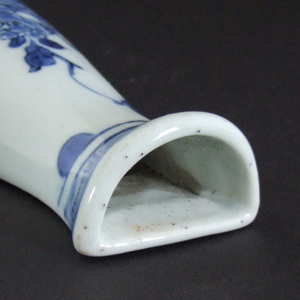
CHONGZHEN 1628 – 1644 Transitional Porcelain
A Pair of Transitional Blue and White Wall Vases, Late Ming Dynasty, Chongzhen Period c.1640. Decorated with a Vase of Flowers to the Center Flanked by a Fish-Bowl to the Left and a Jardinière with a Rock to the Right. In Keeping with Other High-Transitional Porcelain there is `V` Shaped Grass. The Flat Back Pieced for Suspension, Below that a Roughly Drawn Apocryphal Chenghua Mark (Ming Dynasty 1465-1487).
SOLD
- Condition
- In excellent condition, one vase with small chips around the aperture in the back, these are likely to be kiln faults. Minor wear to the back.
- Size
- Height : 16.2 and 16.4 cm (6 1/2 inches)
- Provenance
- N/A
- Stock number
- 23609
- References
- For a blue and white Transitional Porcelain wall vase of this pattern see our `Sold Items` number 22351, and another transitional blue and white wall vase 17898. For a similar Ming blue and white porcelain vase with different design dated to c.1630 see : Seventeenth Century Chinese Porcelain From The Butler Family Collection (Sir Michael Butler, Margaret Medley, Stephen Little, Art Services International,1990) page 114, plate 69. For two similar but shorter and of a more compressed, Transitional blue and white wall vases see : Fine And Important Late Ming And Transitional Porcelain, Recently Recovered from an Asian Vessel in the South China Sea. Property of Captain Michael Hatcher. Christie`s Amsterdam 14th March 1984. Page 18 lot 51 (illustrated) also larger versions lots 52 and 53.
Information
Apocryphal Marks :
Apocryphal marks are frequently encountered on Chinese porcelain, particularly on Kangxi Blue and White Porcelain but also on Transitional porcelain like the present example. The mark of the Ming Emperor Chenghua who reigned from 1465 to 1487 being by far the most common, other Ming marks include Jiajing (1522-1566) and less frequently Wanli (1573-1620). These marks were not added to the piece to deceive, but more as a sign of reverence to earlier potters of the Ming dynasty (1368-1644). Occasionally they are used on pieces copying Ming Porcelain, these objects were probably made for collectors who could not afford the Ming original. Tianqi is an early period for such an apocryphal mark.






